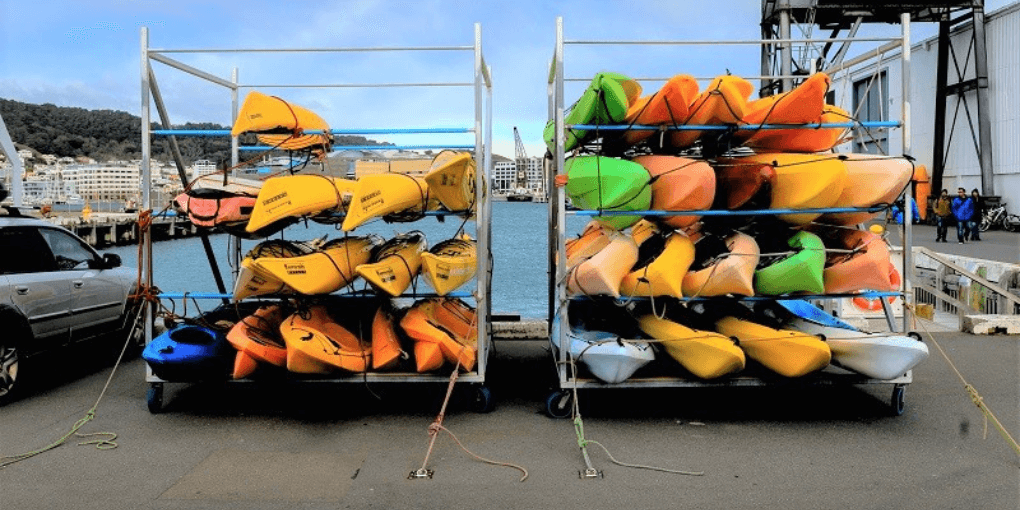Kayak Storage and Transportation: Solutions for Every Paddler
Have you ever had a blast kayaking with friends or family? Well, taking care of your kayak is super important too!
It’s all about making sure your kayak stays safe and ready for your next awesome adventure on the water. That’s why we’re here to learn all about kayak storage!

Let’s start by hearing from our kayak expert, Sarah Paddlestar. She says, “Keeping your kayak safe and cozy when you’re not using it is super important. It’s like giving it a warm hug until you’re ready to take it out on the water again!”
This guide will teach you how to:
- Carry a kayak: With two people, each holding a grab handle and lifting. If you’re on your own, you can lift the kayak onto your shoulders.
- Place a kayak on a vehicle: The simplest method is with the assistance of a friend. You will take up the boat at either end and set it on the rack. If you’re alone, you have a few options based on your rack setup.
- Tie down a kayak: Cam straps are the easiest and fastest way to secure the watercraft.
- Store a kayak: Finally, when you finish your ride and reach home, you need to know how to store the kayak. So, you will get all the concepts about the storage system.
So, get ready to learn some cool tips and tricks to keep your kayak happy and ready for more fun times ahead!
Understanding Kayak Storage
When it comes to keeping your kayak safe and sound, understanding the ins and outs of kayak storage is key.
Think of it as finding the perfect spot for your kayak to take a well-deserved rest when you’re not out paddling.
Let’s dive into the different aspects of kayak storage:
A. Indoor Storage Options:
- Garage Storage Racks: These are like special shelves for your kayak in your garage. They keep your kayak off the ground and out of the way. So you have more space to play.
- Wall-Mounted Storage Solutions: You can hang your kayak on the wall like a piece of art! It’s not just cool-looking; it also keeps your kayak safe from any bumps or scratches.
- Kayak Hoists and Pulley Systems: Imagine lifting your kayak up to the ceiling with the touch of a button! Hoists and pulley systems make storing your kayak up high super easy.
B. Outdoor Storage Considerations:
- Weather Protection: Your kayak doesn’t like getting wet when it’s not in the water! Make sure you cover it up with a special kayak cover to keep it dry and happy.
- Security Measures: Just like you lock the door to your room, you want to keep your kayak safe too! Use a lock or keep it in a secure place to prevent any unwanted adventures.
- Proper Kayak Positioning: Imagine your kayak as a sleeping bag – you want to make sure it’s all comfy and cozy! When storing your kayak, make sure it’s resting flat or on its side to prevent any warping or damage.
Preparing for Transportation
Getting your kayak from home to the water is an exciting part of the adventure! But before you hit the road, it’s essential to prepare for transportation to keep your kayak safe and secure.
Let’s explore some important steps to get ready for the journey:
A. Choosing the Right Vehicle:
- Carrying Capacity and Roof Rack Compatibility: Firstly, you need to choose a vehicle that can safely carry your kayak. Check if your car has a roof rack or if you need to install one to transport your kayak securely.
- Trailer Options for Multiple Kayaks: If you’re going on a paddling expedition with friends or family, consider using a kayak trailer. It’s like a mini caravan for your kayaks to make it easy to transport multiple boats at once.
B. Securing the Kayak:
- Foam Blocks and Straps: Think of foam blocks as comfy cushions for your kayak! Place them on your car’s roof or roof rack to protect your kayak from scratches. Use sturdy straps to secure the kayak to the car tightly.
- J-Cradles and Kayak Mounts: J-Cradles are special racks that hold your kayak securely in place. They’re like giving your kayak a cozy spot to sit during the ride. Kayak mounts are similar but attach directly to your roof rack, providing extra stability.
C. Tie-Down Techniques:
Imagine your kayak as a treasure, and the tie-downs are like the magical ropes keeping it safe!
Use proper tie-down techniques to secure your kayak to your car. Make sure the straps are tight and double-check them before hitting the road to prevent any wobbles or wiggles.
Loading and Unloading Techniques
Loading and unloading your kayak might seem like a daunting task, but with the right techniques, it’s as easy as pie! Let’s explore step-by-step instructions for safely loading and unloading your kayak:
A. Safety Precautions:
- Clear the Area: Make sure the loading and unloading area is clear of any obstacles or hazards.
- Use Assistance: If possible, ask a friend or family member to help you load and unload the kayak. It’s safer and more manageable with an extra pair of hands.
B. Loading Process:
- Position the Kayak: Place the kayak next to your vehicle with the bow (front) facing forward.
- Lift and Slide: Lift the kayak from the side nearest to your vehicle and carefully slide it onto the roof rack or foam blocks. Use your legs to lift, not your back, to avoid injury.
- Center the Kayak: Position the kayak evenly on the roof rack or foam blocks, making sure it’s centered and balanced.
- Secure with Straps: Use sturdy straps to secure the kayak to the roof rack or foam blocks. Crisscross the straps over the kayak and tighten them securely to prevent any movement during transportation.
C. Unloading Process:
- Park Safely: Find a safe and flat area to park your vehicle for unloading.
- Undo Straps: Loosen and remove the straps securing the kayak to the roof rack or foam blocks.
- Lift and Slide: With the help of your friend or family member, carefully lift the kayak off the roof rack or foam blocks and slide it down to the ground.
- Store Safely: Once unloaded, store the kayak in a safe and secure location, either indoors or outdoors depending on your preference and available space.
How to Store Kayak: Step-by-Step
Sure, here’s a step-by-step guide on how to store a kayak properly:
Clean the Kayak: Before storing your kayak, give it a thorough cleaning to remove any dirt, sand, or debris.
Use a mild soap and water solution and a soft sponge or cloth to gently scrub the surface of the kayak.
Rinse it thoroughly with clean water and allow it to dry completely.
Choose a Suitable Location
Decide whether you’ll be storing your kayak indoors or outdoors. If storing indoors, consider options such as a garage, basement, or dedicated kayak storage area.
If you want to store your kayak outdoors, you need to ensure you have a covered area or use a waterproof kayak cover to protect it from the elements.
Position the Kayak
When storing your kayak, it’s essential to position it properly to prevent warping or damage.
Lay the kayak flat on its bottom or on its side, ensuring it’s supported evenly along its length.
Avoid storing the kayak on its hull for extended periods, as this can cause deformation over time.
Use Padding or Support
To prevent pressure points and damage to the kayak’s hull, use foam padding or support blocks at key contact points.
You can place padding under the kayak where it rests on the ground or on storage racks to distribute the weight evenly.
Secure the Kayak
Once positioned correctly, secure the kayak in place to prevent it from shifting or falling over.
If storing indoors, consider using kayak storage racks, wall-mounted brackets, or ceiling hoists to keep the kayak off the ground and out of the way.
If storing outdoors, use straps or ropes to secure the kayak to a sturdy structure to prevent it from being blown over by strong winds.
Cover the Kayak
If storing the kayak outdoors or in an area exposed to the elements, use a waterproof kayak cover to protect it from sun, rain, snow, and debris.
A well-fitted cover will help prolong the life of your kayak and keep it looking like new.
Check Regularly
Periodically check on your stored kayak to ensure it remains in good condition. Look for any signs of damage, warping, or mold/mildew growth, and address any issues promptly.
Conclusion
Properly storing your kayak is essential for maintaining its integrity. It also ensures it’s ready for your next adventure on the water.
By following the step-by-step guide outlined above, you can keep your kayak safe, secure, and in excellent condition for years to come.
Remember to clean your kayak before storing it and choose a suitable location, whether indoors or outdoors, that provides adequate protection from the elements.
Position the kayak correctly, using padding or support to prevent damage to its hull, and secure it in place using storage racks, straps, or ropes.
Regularly check on your stored kayak to ensure it remains in good condition, addressing any issues promptly to prevent further damage.
By taking proper care of your kayak during storage, you can prolong its lifespan. Moreover you also enjoy many more memorable paddling experiences in the future.
So, whether you’re storing your kayak for the offseason or gearing up for your next paddling adventure, remember to follow these guidelines to keep your kayak safe, secure, and ready to hit the water whenever the urge strikes!
FAQs
It's best to keep your kayak indoors if you can, like in a garage or a shed. If you can't keep it inside, try to find a spot outside that's covered and protected from the rain and sun.
Yes, it's a good idea to give your kayak a quick rinse with water and maybe some mild soap to get rid of any dirt or sand. Let it dry completely before putting it away.
Yes, you can! There are special hooks and racks that you can use to hang your kayak on the wall. Just make sure it's hung securely so it doesn't fall down!
If you notice any scratches or dents, don't worry! You can use special kayak repair kits to fix them up. Just follow the instructions carefully, and your kayak will be good as new.


